Variety tomato "Monastic meal": the possibility of using for diet food
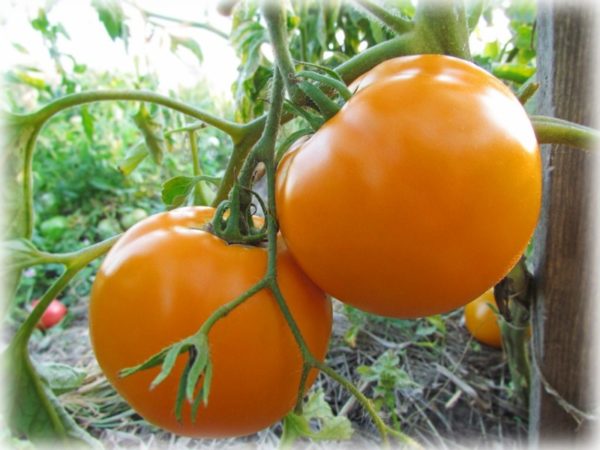
The grade of mid-term of maturing, is intended for cultivation in an open ground and under shelters. Differs in bright coloring of fruits similar to oranges.
Description
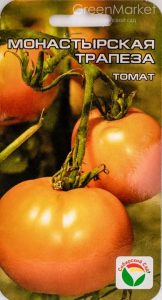 The plant is determinant, grows in open ground up to 1 m high, in greenhouses - up to 1.5 m, has a powerful stem. Bushes are sredneraskidistye, require mandatory garters to support, the foliage is dark green.
The plant is determinant, grows in open ground up to 1 m high, in greenhouses - up to 1.5 m, has a powerful stem. Bushes are sredneraskidistye, require mandatory garters to support, the foliage is dark green.
The fruits are tied with brushes (6-7 per plant), have characteristics:
- The shape is rounded, the fruits are aligned, like twins.
- The color of tomatoes when ripe becomes bright orange, "orange".
- Fruit weight 150-200g, with good conditions of maintenance can reach 400g.
- The flesh is very tender, has a pleasant taste, completely devoid of acid. The skin is thick, smooth.
Fruit ripening occurs within 125-130 days after germination, however, under adverse weather conditions may be delayed. According to reviews of vegetable growers, tomatoes are well dispensed, being removed green.
The use of universal fruits - fresh, salads, in the manufacture of juices and ketchups.
Since the monastery meal tomato by its characteristics and description of the variety is distinguished not only by the excellent taste of fruits, but also by its low content of acid, it is used for dietary nutrition.
Advantages and disadvantages
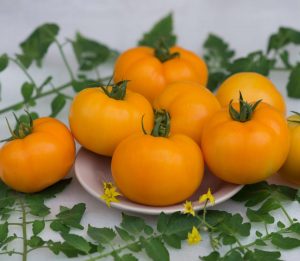 According to responses of summer residents, many claims arise not so much to the quality of the variety itself, as to the work of seed producers - low germination is noted. The tomatoes themselves have the following advantages:
According to responses of summer residents, many claims arise not so much to the quality of the variety itself, as to the work of seed producers - low germination is noted. The tomatoes themselves have the following advantages:
- Great appearance.
- High taste.
- Good keeping quality and transportability.
- Fruit evenness.
- Stable harvest.
- The limited growth of the bush.
- The possibility of using tomatoes in the diet.
The disadvantages include the ability to crack - what happens most often with an excess of moisture, the need for the formation of plants and attachment of the stem to the supports.
See also: A series of tomatoes "Cream giant": a description of varieties
How to grow?
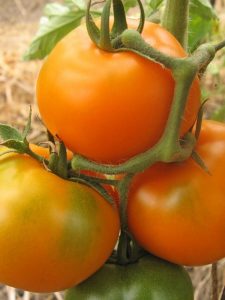 Since the Monastic Meal is a sort of tomato that belongs to the medium early, they prefer to grow it in unprotected soil in the southern regions - with a long summer.
Since the Monastic Meal is a sort of tomato that belongs to the medium early, they prefer to grow it in unprotected soil in the southern regions - with a long summer.
In regions with more severe climatic conditions, they use either the cultivation of tomatoes in the greenhouse or the use of temporary shelters, which allow for earlier planting of plants in the ground.
When growing tomatoes in a short summer, it is important to form a plant correctly - in 1 stem. To guarantee the ripening of fruits, it is necessary to ration the harvest - in the fall, when cold weather sets in, pick flowers and ovaries that take away the food from ripening tomatoes.
Diseases and pests
The variety is susceptible to most diseases of the nightshade, such as late blight, black leg, blotchiness, fusarium. To avoid diseases, you must follow the basic rules of tomato agrotechnology:
- Observe crop rotation - return to the same place or after other plants of the nightshade family after 3-4 years.
- Apply preventive treatment of plants after landing in the ground - with copper-containing preparations, phytosporin.
- When using greenhouses, to disinfect them annually, to change the land or treat them with antifungal preparations.
- Keep plants in comfortable conditions, during watering and feeding, as the development of most diseases occurs in weakened plants.
- Avoid high humidity in greenhouses in order to avoid the occurrence of fungal diseases.
Some vegetable growers use tomato infusion of garlic as folk remedies to combat diseases.
Growing seedlings
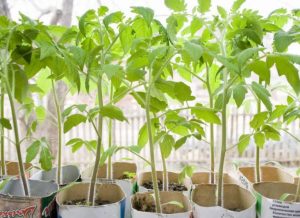 To grow healthy and strong seedlings, the preparation and sowing of seeds begin in advance - 60-65 days before planting in the ground:
To grow healthy and strong seedlings, the preparation and sowing of seeds begin in advance - 60-65 days before planting in the ground:
- Acquire or prepare the soil from a mixture of sod land with humus and peat. If necessary, carry out its treatment with disinfectant solutions.
- Prepare the seeds - treated with a weak solution of potassium perfmanganate, a solution of trace elements.
Sowing is carried out in moist soil in a seedling container to a depth of 5-7mm with an interval of 2-3 cm between seeds. Tara tightly covered and placed in a warm place at a temperature of 24-25 degrees.
Seeds germinate fairly quickly - in 5-7 days, so it is important not to miss the moment of their germination. To avoid sprouting the plants, it is important to plant the plants in the most lighted place - on the window sills or under artificial light lamps.
Seedlings can be hardened - placed in cooler conditions (reduce the temperature by 5-6 degrees) for 10-14 days, then return to a comfortable environment for plants.
See also: Tomato "Red Giant": a productive and productive variety
With the appearance of several true leaves, the seedlings are dive- planted in spacious boxes at a distance of 15-20 cm between plants or in separate containers - pots, cups.
In order for plants to feel comfortable, they need to provide good illumination, they should not obscure each other.
Transplant into the ground
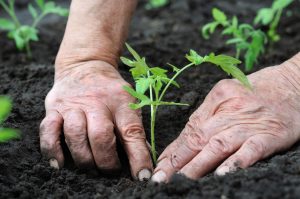 Before planting seedlings prepare beds and greenhouses - they bring humus, ashes, mineral fertilizers.
Before planting seedlings prepare beds and greenhouses - they bring humus, ashes, mineral fertilizers.
Planting of plants start at the onset of sustained heat. In case of sudden frosts, it is desirable to have devices for temporary shelter of plants - arcs, film or spunbond.
Tomatoes are planted in a moist soil, placing 3–4 plants per 1 square meter and placing supports. If when planting seedlings is sunny hot weather, the plants after planting cover from the sun.
Care
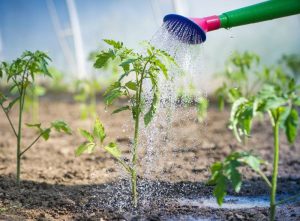 In the first week after planting, they are not touched; further care includes the usual procedures for tomatoes:
In the first week after planting, they are not touched; further care includes the usual procedures for tomatoes:
- Watering - once a week. Good results are obtained by applying drip irrigation, watering directly under the root of tomatoes in special containers.
- Weeding. When weeding, loosening and slight hilling up of the bushes are allowed, since in this case additional roots are formed in the plants.
- Soil mulching. Mulching protects the soil from drying out, does not allow the growth of weeds. If plant residues are used as mulch - grass, weeds (torn out, but without seeds), then when turning over the mulch will supply the plants with nutrients.
- Feeding. In the first weeks after transplanting to the beds, the plants need to increase their weight, so fertilizing is carried out with nitrogen-containing fertilizers - diluted 1:10 with extract of mullein or grass. After the formation of the ovaries, fertilizers are injected, containing predominantly potash and phosphorus constituents.Conducting dressings should be carried out on wet soil.
- When using greenhouses compulsory ventilation, as tomatoes prefer low humidity.
- Garter to supports or trellis. Formations of plants in 1-2 stems, the destruction of stepsons and yellowed lower leaves.
See also: Tomato "Giant red": powerful bushes with weighty tomatoes
While the Monastery Meal tomatoes must be watered in time, one should not forget about the cracking tendency of the variety, which occurs when there is excessive moisture.
According to reviews of gardeners, tomatoes are well dispensed harvested in green, with the creation of conditions can last up to 40 days.
Video: 10 mistakes when growing tomatoes


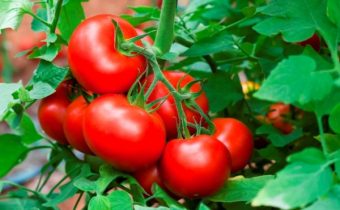
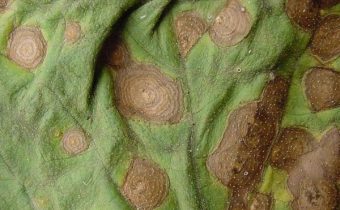
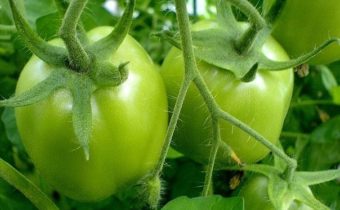
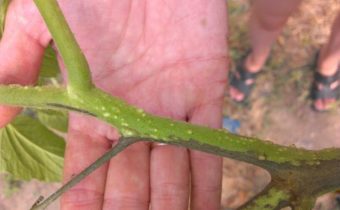
Zoe
“Monastic meal” is my favorite variety, the fruits are of medium size, elastic, tender flesh, no acid, the most important thing in a cup has not been used. I do the seedlings myself, as I can, there were no problems with them, in the garden the bush grows up to a meter, the stem is powerful, nevertheless tying up is required. The variety is medium early, one of the first to bear fruit.